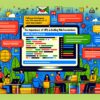Setting Realistic Goals for Your Web Development Journey

Becoming a web developer is an exciting journey filled with opportunities for creativity, problem-solving, and career growth. However, setting realistic goals is crucial to ensuring a satisfying and productive learning experience. This guide will help you understand the importance of attainable objectives and how to set them for success in the realm of web development, specifically focusing on HTML, PHP, CSS, JavaScript, and WordPress.
Understanding the Importance of Realistic Goals
Realistic goals are essential for several reasons. First, they provide clear direction and focus, making your learning path more structured and less overwhelming. Second, attainable objectives help maintain motivation by offering achievable milestones to celebrate along the way. Finally, realistic goals ensure you don’t set yourself up for disappointment, which can happen if expectations are too high from the start.
Breaking Down the Path
The journey to becoming a web developer can be broadly divided into foundational learning, practical application, and specialization.
1. Foundational Learning: This involves understanding the basics of the primary languages and tools used in web development. Becoming proficient in HTML, CSS, PHP, and JavaScript lays the groundwork for all your future projects.
2. Practical Application: Once you have a good grasp of the basics, it’s time to apply this knowledge. Starting with simple projects and gradually increasing complexity is a great way to build your skills. WordPress, being a widely used content management system, provides an excellent platform for practicing and showcasing your abilities.
3. Specialization: As you gain experience, you might find certain areas of web development more appealing than others. Whether it’s front-end development (focusing on the user interface and experience) or back-end development (concentrating on the server-side), setting goals tailored to your interests will make your learning journey more enjoyable and fulfilling.
Setting Your Goals
Short-Term Goals
– Master the Basics: Aim to achieve a comfortable understanding of HTML, CSS, PHP, and JavaScript. Use online resources, tutorials, and practice exercises to strengthen your skills.
– Complete Small Projects: Start with simple projects, such as creating a basic webpage or a simple WordPress theme. These projects will help reinforce what you’ve learned and build your confidence.
Long-Term Goals
– Build a Portfolio: As you gain skills and complete projects, compile them into a professional portfolio. This will be crucial when you’re ready to seek employment or freelance opportunities.
– Specialize: Decide if you want to focus on front-end, back-end, or full-stack development. Dive deeper into your chosen specialty by learning advanced concepts and technologies.
Celebrate Milestones
It’s important to acknowledge and celebrate your progress. Completing a challenging project, learning a new language, or getting your first web development job are all significant achievements in your journey.
Staying on Track
Staying motivated and consistent can be challenging but setting realistic, achievable goals can significantly increase your chances of success. Remember, every web developer started from the beginning, and with perseverance and a clear direction, you can reach your objectives and enjoy a rewarding career in web development.
By understanding the steps involved in becoming a web developer and setting appropriate goals for each stage, you’re already on the path to success. Keep learning, experimenting, and building your portfolio, and you’ll find that your skills and confidence as a web developer will grow exponentially over time.


